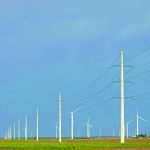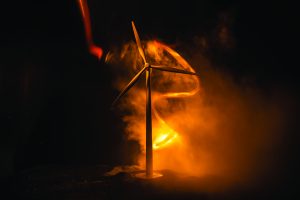If you read my article last month, you may have enjoyed some of the naïve but entertaining questions prospective wind energy students ask the wind instructors during campus tours. As they approach graduation, their questions take on a more serious tone. One recurring theme as of late is related to falling oil prices.
“Will cheap oil drive wind energy out of the electricity market?” is a question I’ve been asked in various ways. While I feel compelled to highlight the positives while still including the negatives, I have developed a lengthy but compelling answer to this question.
According to the Energy Information Administration (EIA), in 1973 when America’s energy industry was rocked by the first OPEC Oil Embargo, roughly 15 percent of our electrical needs were supplied by oil. This was a large enough percentage that electricity bills ate up a much larger portion of the average monthly household budget. This spurned strong public support for renewable energy development. Nixon supported NASA wind energy research, and Carter installed solar panels on the roof of the White House. Three world-class wind sites — Altamont Pass, Tehachapi, and San Gorgonio Pass — experienced heavy wind farm development in California beginning in 1979. By 1986, however, Americans settled into the comforts of stable economic growth including relatively stable and cheap oil prices. Renewable energy fell out of favor, although oil played a continuously smaller role in the great pie graph of electrical energy sources as well. Instead, cheap coal and natural gas were listed as America’s foundational power sources. Today, only about 0.3 percent of America’s electrical needs are met directly by the burning of oil. Apparently, wind and oil no longer compete with each other in the electrical energy market.
Oil has become almost exclusively a transportation fuel. There is little overlap between the use of oil and wind for the purpose of transportation. Wind is only a transportation fuel to the extent that America’s fleet of electric vehicles recharge from the grid. In an October 2014 blog post, the Sierra Club celebrated when electric vehicle sales hit an all-time high of 0.85 percent of monthly vehicle sales. It may seem like we are seeing Teslas and Nissan Leafs everywhere we go, but they are still a tiny portion of the transportation energy market where petroleum reigns supreme. Clearly, wind and oil do not compete very much in the transportation energy market either.
So does the price of oil have any impact on wind energy? You bet it does! Cheap oil and the resultant cheap transportation fuels it derives have a very favorable impact on wind farm construction budgets including lower costs for manufacturers. According to the American Logistics Association, fuel costs can account for up to 65 percent of an industry’s logistics budget. Lower fuel costs leave more room in the budget for profits for OEMs, wind farm developers, and owners. Every turbine, component, tool, and service truck can move about the country at a lower cost when the price of oil is low. It stands to reason that this encourages stronger investment in wind energy as well. However, this leads us into more complicated questions regarding the availability of investment capital.
Energy investors often hedge their bets by diversifying amongst various energy sources and service providers. Losses in upstream oil production revenue leaves some heavy hitter investors with less cash to invest in other energy options. On the other hand, pessimism in oil stocks makes renewable energy stocks look pretty attractive and promising to those who can justify the cash outlay. If British Petroleum had not divested itself of most of its wind holdings a couple of years back, it may have enjoyed the hedge against its 20 percent loss in stock price since May 2014.
Warren Buffett’s Berkshire Hathaway is a mixed bag when it comes to the drop in oil prices. Burlington Northern Santa Fe railroad, a Berkshire Hathaway holding, profited handsomely from the transport of Bakken petroleum until drilling efforts backed off recently. Soon, rapid decline rates in the production from Bakken wells will result in falling revenue for BNSF. However, Berkshire holdings in retailers such as Walmart will benefit from cheaper logistics. Most importantly, Berkshire Hathaway Energy (BHE) has been making bold investments in renewable energy through holdings like MidAmerican Energy, Pacificorp, and NV Energy. Of these investments, 60 percent of the installed capacity will be in wind energy. It seems Warren Buffett shares my views on the benefits of fixed energy costs that wind energy provides. I’m sure he’ll sleep better at night knowing that we agree on this.
The pink elephant in the room cannot be ignored. How is the competition between wind and coal affected by low oil prices? Simply stated, when oil is cheaper, coal is cheaper. Mining and transport costs of coal drop. This certainly does not guarantee increased investment in coal-fired power plants, however. The threat of an eventual carbon tax makes this idea far too risky, but… we must consider how newly installed wind energy must compete with the existing capacity for coal to power our grid with cheap, reliable energy. This competition in coal-rich states does have a negative impact on the risk inherent in any new power plant investment, wind being no exception. To remain optimistic amidst this debate, we must consider the long-term perspective. Oil, as a nonrenewable resource with proven price instability, will not always help coal maintain its affordability. Coal-fired power plants require lifelong input of its market-priced fuel. Wind energy, on the other hand, is a heavily front-loaded investment. Wind farms require a very large initial investment with relatively inexpensive and predictable O&M costs for the remainder of their service life of 20 to 25 years. Unlike coal, the input fuel for a wind farm is free. If we can cut a sizeable portion of wind energy development costs while oil prices are low, then investors should take advantage of this in the interest of hedging against future increases in oil prices. Profitability of coal will inevitably decline as oil prices increase, but the cost savings will have already been locked into the levelized cost of energy (LCOE) of wind farms. With or without a power purchase agreement, this adds up to savings that any utility or utility customer will enjoy.
In light of cheap oil, I feel confident in telling my students that their future in wind energy is secure and bright. They will see astronomical growth in our industry in the next decade, and cheap oil only helps us grow even faster than many of us had expected. If oil prices rise again, as I believe most energy economists expect, wind energy will still benefit by offering fixed, predictable costs and profits in an otherwise chaotic energy market.




































